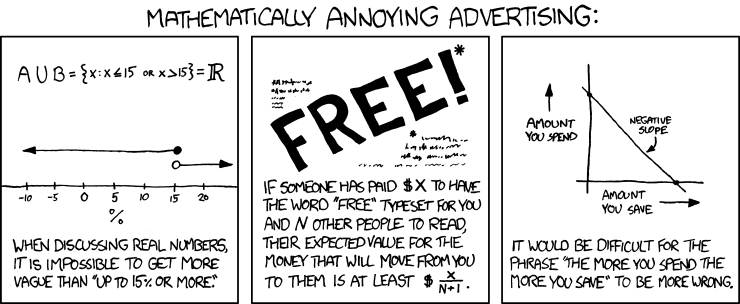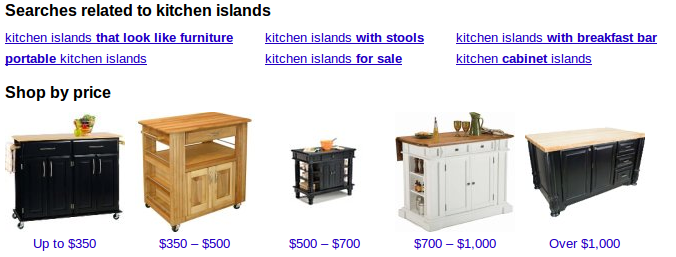The most recent xkcd:

(As usual, click on the image for a larger version.)
I'm not sure that Randall is right about the first panel. It's true that "up to X or more", for some number X, seems by simple compositional semantics to cover the entire number line. But if a store were to raise its prices by 10% across the board, I believe that all rational people would regard the statement "You will save up to 15% or more on your purchases" as false, despite the fact that -10 is on the real line (and on Randall's representation of it).
And lawyers also use "false" differently from logicians, I think. Thus NY Code - Section 350-A says that
In this case, then, the law and ordinary language might be in reasonable alignment.
I say "might" because phrases of the form "up to * or more" are very common in advertising. And I know from experience that the named percentage or amount is often associated with a small number of options in weird sizes and styles, but I've never heard of a regulatory complaint about such ads.
Analogous phrases occasionally occur in journalistic writing, e.g. this Consumer Reports article on kitchen remodeling:
In such cases — and perhaps in the more honest ads as well — something really is being communicated, namely an approximate statement about a distribution. I conclude from the last sentence of that Consumer Reports paragraph that if I shop for kitchen islands, I should expect to find plenty of options in the range from $150 to $1,000, with a perhaps-long tail of higher-priced offerings. And indeed, this is exactly what I find:


(As usual, click on the image for a larger version.)
I'm not sure that Randall is right about the first panel. It's true that "up to X or more", for some number X, seems by simple compositional semantics to cover the entire number line. But if a store were to raise its prices by 10% across the board, I believe that all rational people would regard the statement "You will save up to 15% or more on your purchases" as false, despite the fact that -10 is on the real line (and on Randall's representation of it).
And lawyers also use "false" differently from logicians, I think. Thus NY Code - Section 350-A says that
The term "false advertising" means advertising, including labeling, of a commodity, or of the kind, character, terms or conditions of any employment opportunity if such advertising is misleading in a material respect. In determining whether any advertising is misleading, there shall be taken into account (among other things) not only representations made by statement, word, design, device, sound or any combination thereof, but also the extent to which the advertising fails to reveal facts material in the light of such representations with respect to the commodity or employment to which the advertising relates under the conditions prescribed in said advertisement, or under such conditions as are customary or usual.
In this case, then, the law and ordinary language might be in reasonable alignment.
I say "might" because phrases of the form "up to * or more" are very common in advertising. And I know from experience that the named percentage or amount is often associated with a small number of options in weird sizes and styles, but I've never heard of a regulatory complaint about such ads.
Analogous phrases occasionally occur in journalistic writing, e.g. this Consumer Reports article on kitchen remodeling:
Whether it's a permanent unit with furniture-style looks or a small portable one on casters, an island adds work and storage space. The style should complement your cabinets, but it needn't match exactly. A wood island can add warmth to a white kitchen, and a painted finish can inject color into an all-wood one. Be sure that there is at least a 42-inch clearance around the island to ensure easy access and smooth traffic flow. Prices start around $150 and go up to $1,000 or more.
In such cases — and perhaps in the more honest ads as well — something really is being communicated, namely an approximate statement about a distribution. I conclude from the last sentence of that Consumer Reports paragraph that if I shop for kitchen islands, I should expect to find plenty of options in the range from $150 to $1,000, with a perhaps-long tail of higher-priced offerings. And indeed, this is exactly what I find:

Source: http://languagelog.ldc.upenn.edu/nll/?p=3020
No comments:
Post a Comment